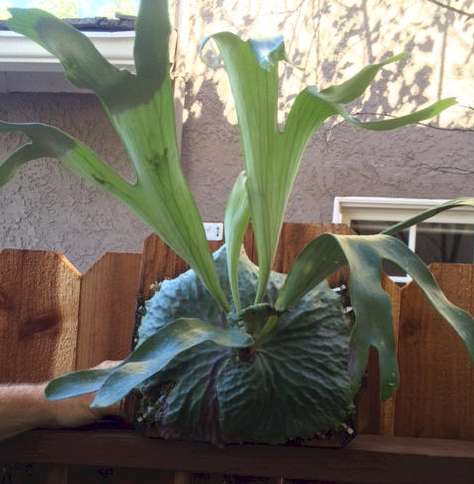|
Platycerium Dawboy Hybrid (P. alcicorne x P. madagascariense) |
|
The Platycerium Dawboy is a
new hybrid out of Thailand. It is a mix of P. madagascariense
and P. alcicorne. The shield fronds defiantly show the P.
madagascariense waffling. The fertile fronds are more P.
alcicorne and stand longer and more erect. The plant is small
like P. madagascariense. The P. alcicorne is native to Madagascar and East Africa. The fertile fronds of the P. alcicorne from Madagascar is characteristically; wide, and dark green. Whereas the P. alcicorne from East Africa is yellow green, waxy, hairless and narrow compared to the Madagascar variety. The P. dawboy is characterized by having the dark green, wide fertile fronds with spore patched on the tips. The photo above is from Tom Gauci's collection and the spore patch covers the full width of the frond from above the lobe to about 1 inch from the tip. Other P. dawboy photos show the spore patch mostly above the lobe and stopping just beyond the lobe.
The P. Dawboy is a hybrid from Thailand suggesting
the need to grow in a high humidity. However Tom Gauci is
growing it outside in Southern California, about 5 miles from the
beach. The average humidity is probably about 30%. I just
received two new P. Dawboys from Thailand. I plan to grow one in
my green house and the second outside. I also live about 4 miles
from the beach in Southern California. |
  The
P. dawboy left and right are from Siam Exotica Plants in
Thailand. The
P. dawboy left and right are from Siam Exotica Plants in
Thailand. |
|
|
| The reader must realize that many hybrids are a result of accidental mixing of spore when similar plants are grown in close proximity. Even when spore from two species are intentionally crossed, it is always possible for a spore from an unintended species to contaminate the intended cross. After repeated attempts and proof that their progeny have the same traits, then we can agree as to the parentage and define it as a new hybrid and not just a sport or cultivar of a species. This can take a long time with slow growing platyceriums and experienced growers are hesitant to jump the gun and name a hybrid. So when we discuss hybrids, we need to consider all the variables. Soon we will have more definite DNA studies. Until DNA testing is more readily available, and established parent base lines defined, we must look at and compare traits from other species and deduct a logical inference to the actual parentage and these are considered individual plants and not necessarily a hybrid. |
